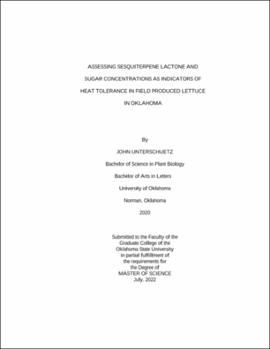| dc.contributor.advisor | Hu, Bizhen | |
| dc.contributor.author | Unterschuetz, John | |
| dc.date.accessioned | 2023-04-12T19:38:44Z | |
| dc.date.available | 2023-04-12T19:38:44Z | |
| dc.date.issued | 2022-07 | |
| dc.identifier.uri | https://hdl.handle.net/11244/337389 | |
| dc.description.abstract | Lettuce (Lactuca sativa L.) is a cool season vegetable typically grown in the spring and fall in Oklahoma by small farmers. Lettuce is not typically grown in the heat of the summer because excessive heat stress causes premature bolting, tip burn and bitter off-flavor. Premature bolting is known to increase the concentration of sesquiterpene lactones (SLs) in lettuce, which cause lettuce to be perceived as bitter when tasted by the consumer. However, sugar production in lettuce can counteract the bitterness imparted by greater amounts of SLs and mask their bitter taste. Eighteen cultivars of lettuce, representing five market types (Loose Leaf, Romaine, Summer Crisp/Batavian, Butterhead, and Salanova®) were grown in field plots during spring, summer and fall harvest seasons. Canopy width and plant height were observed in the field along with yield immediately following harvest. Twelve cultivars were selected for SL and sugar analysis. The concentrations of the SLs lactucin, 8-deoxytactucin, and lactucopicrin were quantified by high performance liquid chromatography (HPLC) along with the concentrations of glucose, sucrose, and fructose, quantified by gas chromatography (GC). Micro sprinkler irrigation technology was also investigated as a mechanism for cooling lettuce in the summer season via evaporative cooling. Spring was the best season to grow lettuce in Oklahoma based on superior Sugar/SL ratios and yields. Romaine and Batavian cultivars are the recommended types of lettuce to grow based on their high yields and consistently high Sugar/SL ratios, in both the spring and fall offseason of production. Salanova® cultivars in general yielded less and had lower Sugar/SL ratios in every season when compared to other types tested. Genetically similar green and red lettuces were investigated and there was no evidence that red lettuce cultivars accumulate less sugar and more SLs compared to green lettuce cultivars. Micro sprinkler irrigation did not increase sugars or decrease SLs, nor did it increase yield, and is not recommended for use to extend the growing season of lettuce. | |
| dc.format | application/pdf | |
| dc.language | en_US | |
| dc.rights | Copyright is held by the author who has granted the Oklahoma State University Library the non-exclusive right to share this material in its institutional repository. Contact Digital Library Services at lib-dls@okstate.edu or 405-744-9161 for the permission policy on the use, reproduction or distribution of this material. | |
| dc.title | Assessing Sesquiterpene lactone and sugar concentrations as indicators of heat tolerance in field produced lettuce in Oklahoma | |
| dc.contributor.committeeMember | Maness, Niels | |
| dc.contributor.committeeMember | Dunn, Bruce | |
| osu.filename | Unterschuetz_okstate_0664M_17838.pdf | |
| osu.accesstype | Open Access | |
| dc.type.genre | Thesis | |
| dc.type.material | Text | |
| dc.subject.keywords | heat tolerance | |
| dc.subject.keywords | lettuce | |
| dc.subject.keywords | micro sprinkler irrigation | |
| dc.subject.keywords | sesquiterpene lactone | |
| dc.subject.keywords | sugar | |
| dc.subject.keywords | variety trial | |
| thesis.degree.discipline | Horticulture | |
| thesis.degree.grantor | Oklahoma State University | |
